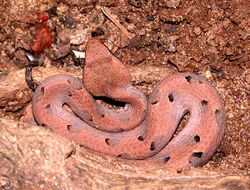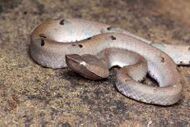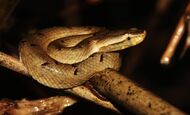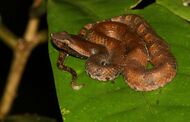Hypnale
Topic: Biology
 From HandWiki - Reading time: 3 min
From HandWiki - Reading time: 3 min
| Hypnale | |
|---|---|

| |
| Hump-nosed viper, H. hypnale. | |
| Scientific classification | |
| Domain: | Eukaryota |
| Kingdom: | Animalia |
| Phylum: | Chordata |
| Class: | Reptilia |
| Order: | Squamata |
| Suborder: | Serpentes |
| Family: | Viperidae |
| Subfamily: | Crotalinae |
| Genus: | Hypnale Fitzinger, 1843[1] |
Hypnale is a genus of venomous pit vipers endemic to Sri Lanka and southwestern India .[1] Three monotypic species are currently recognized (no subspecies).[4] All members have more or less upturned snouts that produce a hump-nosed effect.[2]
Description
Members of this genus grow to a maximum total length of 55 cm (21 5⁄8 in) (for H. hypnale). The body is stout, but relatively slender compared to most other crotalines. The tail length accounts for 14-18% of total length in males, 11-16% in females.[2]
The snout is more or less upturned, with two species having a wart-like protuberance at the tip that is covered with tiny scales. The anterior head shields are strongly fragmented, but the frontal scale, supraoculars and parietals are complete and quite large. The nasal scale is single, but it may have a groove that extends towards its upper edge. There are two preoculars and 2-4 postoculars. The loreal scale is single, but extends across the canthus rostralis so that it can be seen from above. The supralabials and sublabials both number 7-9. Bordering the supralabials are 3-4 enlarged temporal scales, above which are 3-5 irregular rows of temporal scales. There is one pair of chin shields, each of which is slightly longer than it is wide.[2]
At midbody there are 17 rows of dorsal scales, which are weakly keeled. Apical pits are present, but very difficult to see. The keels are faint or may be entirely absent on the first two scale rows bordering the ventrals. The ventral scales number 120-158, while the subcaudals vary in number from 28-48 (almost all are paired).[2]
Geographic range
Species of the genus Hypnale are found in Sri Lanka and India ,[1] from almost sea level to an elevation of at least 1,829 m (6,001 ft). In India they are found in the Western Ghats as far north as 16° north latitude.[2]
Habitat
They occur in dense jungles, dry forests, rain forests, both in low and hilly country, and in plantations. They sometimes are also found near or in human habitations.[2]
Behavior
They are mostly nocturnal, but are often seen coiled in the shade during the day, moving around on cloudy days or under low light conditions. They are generally inoffensive, both in the wild and in captivity, rarely attempting to bite unless restrained or injured.[2]
Feeding
Their diet includes lizards, snakes, frogs, reptile eggs, and small mammals.[2]
Reproduction
All members of this genus are viviparous.[2]
Species
| Image | Species[4] | Taxon author[4] | Common name[2] | Geographic range[1] |
|---|---|---|---|---|

|
H. hypnaleT | (Merrem, 1820) | Hump-nosed viper | Peninsular India to the Western Ghats as far north as 16° N, and Sri Lanka. |

|
H. nepa | (Laurenti, 1768) | Sri Lankan hump-nosed viper | In Sri Lanka throughout forested areas, from lowland rainforest to over 1,800 m (5,900 ft) altitude. |

|
H. zara | (Gray), 1849 | Gray's hump-nosed viper | Sri Lanka. |
T) Type species.[1]
A new species called Hypnale sp. Amal, recently described, but not yet given species status.
Taxonomy
According to Gloyd and Conant (1990), members of this group seem to be closely related to the genus Calloselasma.[1]
References
- ↑ 1.0 1.1 1.2 1.3 1.4 1.5 McDiarmid RW, Campbell JA, Touré T. 1999. Snake Species of the World: A Taxonomic and Geographic Reference, vol. 1. Herpetologists' League. 511 pp. ISBN:1-893777-00-6 (series). ISBN:1-893777-01-4 (volume).
- ↑ 2.00 2.01 2.02 2.03 2.04 2.05 2.06 2.07 2.08 2.09 2.10 Gloyd HK, Conant R. 1990. Snakes of the Agkistrodon Complex: A Monographic Review. Society for the Study of Amphibians and Reptiles. 614 pp. 52 plates. LCCN 89-50342. ISBN:0-916984-20-6.
- ↑ Brown JH. 1973. Toxicology and Pharmacology of Venoms from Poisonous Snakes. Springfield, Illinois: Charles C. Thomas. 184 pp. LCCCN 73-229. ISBN:0-398-02808-7.
- ↑ 4.0 4.1 4.2 "Hypnale". Integrated Taxonomic Information System. https://www.itis.gov/servlet/SingleRpt/SingleRpt?search_topic=TSN&search_value=634415. Retrieved 3 November 2006.
Further reading
- Boulenger, George A. 1890. The Fauna of British India, Including Ceylon and Burma. Reptilia and Batrachia. Secretary of State for India in Council. (Taylor & Francis, Printers). London. xviii + 541 pp.
- Doblado, R. 2005. Hypnale hypnale - the Indian Humpnose Viper. Reptilia (GB) (38): 64-70.
- Fitzinger, L. 1843. Systema Reptilium: Fasciculus Primus: Amblyglossae. Braumüller & Seidel. Vienna. 106 + vi pp. + Index. ("Gen. Hypnale", p. 28.)
- Gumprecht, A.; Tillack, F.; Orlov, N.L.; Captain, A.; & Ryabow, S. 2004. Asian Pit Vipers. Geitje Books. Berlin, 368 pp.
- Parkinson, C.L. 1999. Molecular systematics and biogeographical history of Pit Vipers as determined by mitochondrial ribosomal DNA sequences. Copeia 1999 (3): 576-586.
- http://www.biologyofthepitvipers.com/#!Hump-nosed-pit-viper-Viperidae-Crotalinae-Hypnale-Venom-envenomation-and-antivenom/c1oxy/BA768453-4A27-459F-9F68-28BF31206214
External links
| Wikimedia Commons has media related to Hypnale. |
- Hypnale at the Reptarium.cz Reptile Database. Accessed 12 December 2007.
Wikidata ☰ Q2531557 entry
 |
 KSF
KSF